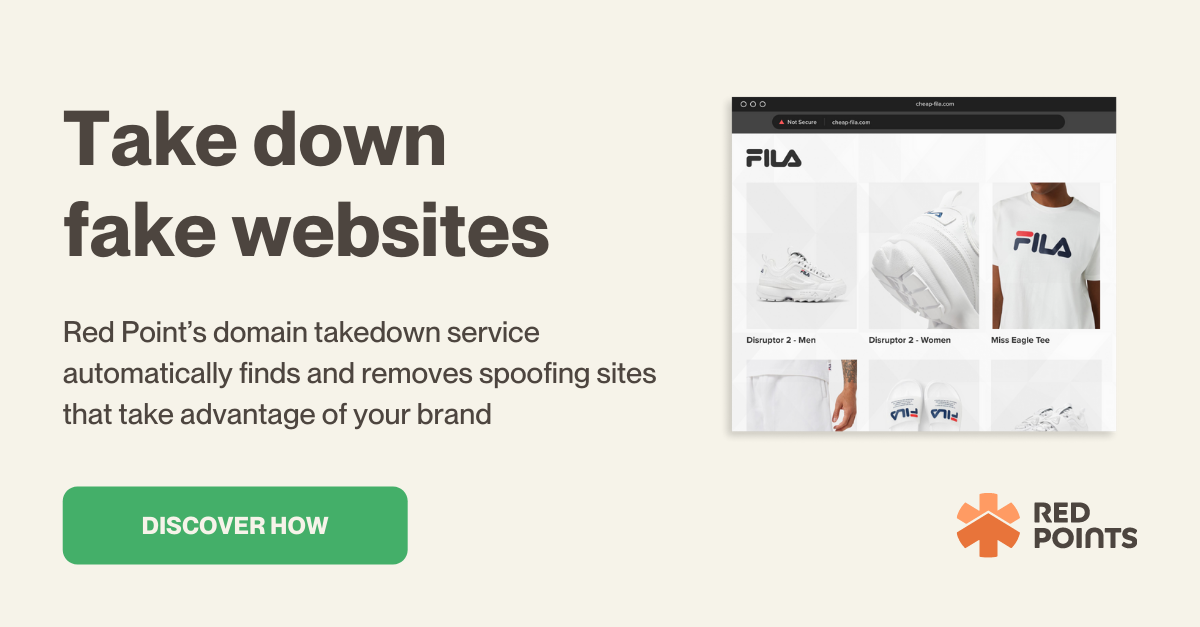Many brands use Shopify as a convenient way to reach their target audience and provide easy access to their products online. However, the ecommerce site also poses a threat to brands. Among the legitimate brands selling products on Shopify are thousands of sellers with scam Shopify stores.
Fraud on Shopify is a threat your brand should be prepared for. Scammers selling fakes on Shopify can not only take revenue from your brand but can also ruin your brand reputation. Luckily, there are steps you can take to protect your brand from these scammers, so read on to learn more.
Summary:
- Scam Shopify stores steal from brands whose revenue and reputation are negatively impacted
- Monitoring for these fake Shopify stores and submitting takedowns is essential for brands
How do scam Shopify stores impact businesses?
Shopify scams using your branded content put your customers, revenue, and brand at risk. The impersonator reduces traffic to your site by attracting potential customers to theirs, and in turn, decreases revenue. Money customers spend on the fake Shopify store is money they won’t be spending on your real brand and products.
Customers duped by fraud on Shopify then receive low-quality, knock-off products, or sometimes receive nothing at all. Not only that but their sensitive information like credit card numbers and addresses has been shared with these scammers, who can continue abusing this information. It’s no surprise that these shoppers get upset after being scammed, and more often than not, this negatively impacts your brand more than the scammer.
After shoppers are defrauded by Shopify scams impersonating your brand, they often come back to your legitimate store to vent their frustrations. Some may not even know they got scammed by a fake Shopify store and may report your real store. This can lead to increased complaints and negative reviews that tarnish your brand reputation and ruin the trust you built with your loyal customers.

Examples of scam Shopify stores
Fraud on Shopify certainly isn’t a rare problem for consumers, as there are countless examples of consumers getting scammed by these fake stores. The methods scammers use in these examples vary, which can make it difficult for brands to protect against.
John Koetsier, for example, is one such shopper scammed by these fake Shopify stores who told his full story in this Forbes article. John was lucky enough to know the extremely marked-down dumbbells he saw advertised were likely too good to be true. He purchased them knowing the company “GearsRice” was likely a scam website and used PayPal to make the purchase.
The dumbbells he ordered never arrived. Luckily, he was refunded by PayPal, but the “company” itself never got in contact with him about any replacements or refunds. In this case, the scammers were making money from consumers buying this fake product and hoping they would forget to request a refund.
Some consumers who buy from scam Shopify stores aren’t as lucky as John, though. Another fake Shopify store recently taken down by the platform was MDRN Supply Co, which was selling counterfeit luxury goods from brands like Louis Vuitton. Shopify only found out about the fake store after many consumers complained they had never received their orders.
In these situations, it can be very difficult for consumers to get a refund on their order. The fake stores rarely respond to complaints and keep operating until they are shut down. This is another reason brands need to monitor websites and ensure they take the proper steps to take them down when they arise.
Reporting scam stores on Shopify
If you find a scam store on Shopify infringing on your brand, follow these simple steps to report the store to Shopify and get it taken down:
Step One: Go to Shopify’s reporting page and choose the option that fits best. If the fake Shopify store is using your brand’s content, “Intellectual Property” is likely the best choice.
Step Two: Provide your personal information. Shopify will ask for your name, company, and contact info.
Step Three: Provide links to the information you are reporting. This could be the web page if they’ve copied your entire website or specific products they have posted.
Step Four: Sign your report request with your electronic signature and submit it.
Shopify will then contact you to follow up on whether they have accepted your fake store report.
What’s next
Your brand needs to monitor Shopify stores to ensure fraudulent activity and IP infringements are detected as soon as possible. Scam Shopify stores prey on your customers and pose a threat to your revenue as well as your brand reputation.
Red Points makes it easy to scan and report scam websites 24/7 and keep your brand protected.
To learn more, request a demo of the website takedown solution.






